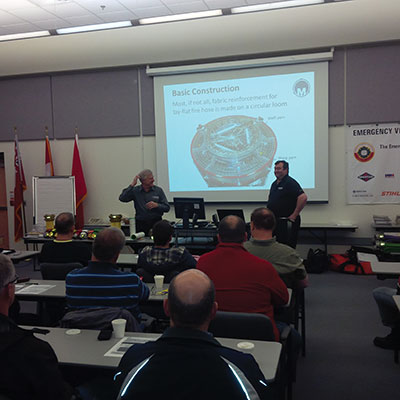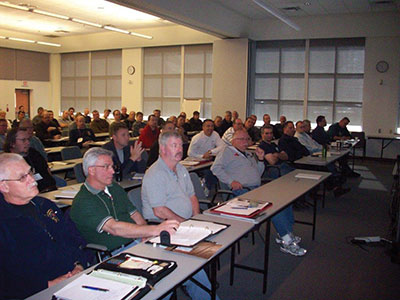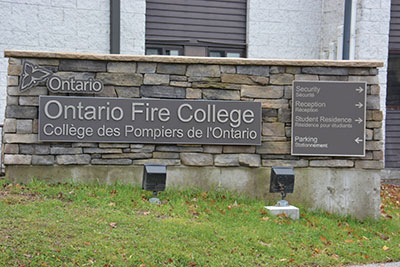
Equipment
Truck Tech: September 2014
The Emergency Vehicle Technicians Association of Ontario (evtao.ca) is a small, non-profit member body of fire-department mechanics that oversees and helps to develop training courses that can be shared with other fire-department mechanics.
August 28, 2014
By Chris Dennis
The Emergency Vehicle Technicians Association of Ontario (evtao.ca) is a small, non-profit member body of fire-department mechanics that oversees and helps to develop training courses that can be shared with other fire-department mechanics.
The association’s goal is to improve the skills of those who work on fire-department vehicles and make sure mechanics are up to date on standards and repair and maintenance techniques.
 |
|
| Photo 1: It takes a year to prepare for mechanics week at the fire college, and those who organize the training do so on their own time, and usually on their own dime. Photo by Chris Dennis. | |
 |
|
| Photo 2: Getting together to learn often leads to problem solving and discussions about issues common to all departments; sharing that information makes your department better. Photo by Chris Dennis.
|
|
 |
|
| Emergency vehicle technicians should keep up to date on improvements and enhancements; spending time together at courses such as that offered annually by the Emergency Vehicle Technicians Association of Ontario at the Ontario Fire College gives colleagues opportunities to brainstorm solutions to vehicle issues and maintenance challenges. Photo by Laura King Advertisement
|
Not all provinces require fire-department mechanics – or outside contractors who work on fire-department trucks – to be emergency vehicle technicians (EVTS), but with NFPA changes in the works, EVT certification may become mandatory.
As is the case for fire-operations personnel, there is a group of NFPA standards to assist with maintaining and repairing fire trucks and equipment. A series of guidelines has been set out for maintenance personnel: NFPA 1901, NFPA 1071, and NFPA 1936 are a few.
In Ontario, you must be a certified mechanic to work in a retail business at which services rendered are paid for. In a municipal environment, it is up to the hiring body to employ certified or non-certified mechanics. In most cases, cities do not charge for internal repairs or maintenance, so a certified person may not be part of the job description.
Some municipalities have their own fleet services. They look after city salters, dump trucks, pick-up trucks, utility vehicles, lawn equipment and other municipal needs. The fire department uses these in-house facilities to do their work, but at times it is also a heartache if the technician who repairs lawn equipment suddenly has to do a fire-pump repair without being trained.
The North American EVT program (www.evtcc.org) provides maintenance training specific to emergency vehicles. For the fire service, it covers transmissions, fire pumps, aerials, electronics, vehicle specing and other areas.
Members of Ontario’s EVT association met at the Ontario Fire College in Gravenhurst in the spring. The agenda included motivational speakers, trainers and round-table discussions.
Every year at our training session, there are apparatus-maintenance people, from technicians who work for full-time fire department maintenance divisions to fire-department-trained fleet technicians, to firefighters who just monitor and maintain the fleet for the department. Regardless of the person’s title, he or she must stay current in order to deal with things like liability issues. In past columns I have talked about internal audits, accident of investigations with apparatus, and equipment malfunctions. If there had been a repair done on something that is directly related to human or property damage, the first place an investigator will go is the maintenance department (or the mechanic). The EVT program sets out wonderful guidelines to cover all avenues of preventative maintenance schedules and timelines.
It takes a year to prepare for mechanics week at the fire college, and those who organize the training do so on their own time. The trainers and the speakers come from Canada and the United States, and they, too, usually do this on their own dime. We have also been supported heavily by the OEM vendors who sell fire trucks or equipment and fire departments that lend us their trucks for the week.
This year’s program consisted of a two-day steering and brakes theory and overhaul class and sessions on safety-restraint systems, compressed-air foam systems course theory and rebuild, fire pumps, aerial overviews, auto extrication tool overhaul and maintenance, roll-up door maintenance and overhaul, Wheldon Multiplex systems (entry level and advanced), fire nozzle and monitor overhaul, EVT study courses, engine courses, fire-hose manufacturing and repair. Speakers focused on moving up through the chain of command, mentoring, professionalism, respectful workplaces, life insurance, and health issues.
During the round-table discussion, all technicians had a chance to talk about repairs or defeats they have come across while maintaining fire trucks and equipment. Whether it be a Pierce Spartan, a Smeal, or a commercial truck, its all nuts and bolts and when a bunch of gearheads get together and they not only take apart a fire truck, they also take apart and repair a problem somebody else may have come up against.
The big topic of discussion this year was corrosion – not only paint on the body, but electrics too. Lots of great ideas were shared – including our system for dealing with winter salt and brine.
I recommend that all fire-department technicians attend one of these EVTAO weeks, or something similar in your home province, at least once. Your department will be better for it and be one step closer to being technically and preventative ready.
Something as simple as records-keeping and filing starts with the technician doing your maintenance work; if there is a paper trail – even for a simple headlight change – you are showing due diligence and will be better off.
These are the tracks required for EVT certification in the fire service.
- F1 Maintenance, Inspection, and Testing of Fire Apparatus
- F2 Design & Performance Standards of Fire Apparatus
- F3 Fire Pumps & Accessories
- F4 Fire Apparatus Electrical Systems
- F5 Aerial Fire Apparatus
- F6 Allison Automatic Transmissions
- F7 Foam Systems
If your techs are EVTs now, and are wondering if they should continue on that track, my answer is yes – what better way to know something than to be trained on it exclusively? It’s like live fire; unless you have trained with it and understand it, you will never know it.
Remember, rubber side down, my friends.
Chris Dennis is the chief mechanical officer for Vaughan Fire & Rescue Services in Ontario. He can be reached at Chris.Dennis@vaughan.ca
Print this page